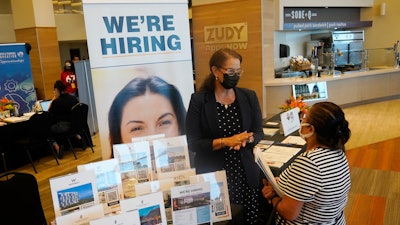
WASHINGTON (AP) — U.S. employers added a burst of 467,000 jobs in January despite a wave of omicron infections that sickened millions of workers, kept many consumers at home and left businesses from restaurants to manufacturers short-staffed.
The government's report Friday also drastically revised up its estimate of job gains for November and December by a combined 709,000. It also said the unemployment rate ticked up last month from 3.9% to a still-low 4%.
The strong hiring gain for January, which was unexpected, demonstrates the eagerness of many employers to hire even as the pandemic maintains its grip on the economy. Businesses appear to have seen the omicron wave as having, at most, a temporary impact on the economy and remain confident about longer-term growth.
“Employers have assumed that omicron would be painful but short term, so they haven’t changed their hiring plans,” said Mathieu Stevenson, the CEO of Snagajob, a job listings site focused on hourly workers. “Demand from employers is as strong as ever.”
The surprisingly healthy hiring figures will likely give the Federal Reserve leeway to raise interest rates more quickly to cool inflation. The Fed has already indicated that it will begin raising rates in March, and it could do so again at its next meeting in May.
Dow Jones futures dipped immediately on the expectation that the Fed could accelerate its efforts to tighten credit, which would slow borrowing and spending and potentially weaken the economy.
The overall outlook for the job market remains bright, with openings near a record high, the pace of layoffs down and the unemployment rate having already reached a healthy level. The nation gained more jobs last year, adjusted for the size of the workforce, than in any year since 1978. The unemployment rate fell by nearly 3 percentage points — from 6.7% to 3.9% — the sharpest yearly decline on records. Much of that improvement represented a rebound from record job losses in 2020 that were driven by the pandemic recession.
Yet the economy’s strong growth and hiring gains were accompanied by the highest inflation in four decades, magnified by brisk consumer spending on furniture, electronics, appliances and other goods and vast infusions of federal aid that has now largely expired.
Snarled supply chains hampered the availability of many goods, especially new and used vehicles, forcing prices up sharply. Prices of food, energy and housing soared, too. High inflation has wiped out many Americans’ pay gains.
Omicron infections are likely slowing the economy in the January-March quarter, particularly compared with the rapid expansion in the final three months of 2021, when it grew at a robust 6.9% annual rate. Some analysts have forecast that growth will weaken to an annual rate as low as 1% in the first three months of this year.
One reason for the slowdown: Americans cut their spending in January as the spread of the coronavirus discouraged some people from eating out, traveling and going to movies and other entertainment venues.
Yet as omicron fades, there are signs that consumers are poised to spend again. Auto sales jumped in January after several months of declines. Carmakers have managed to slowly ramp up production. And Americans’ incomes rose at a solid pace last month, providing fuel for future spending.






















